Impact of Communication Gap on Deloitte's Organisational Behavior
VerifiedAdded on 2022/09/30
|12
|2219
|22
Project
AI Summary
This research proposal investigates the impact of communication gaps on organizational behavior and profitability within Deloitte. The study introduces the significance of organizational communication, explores communication structures and models, and identifies communication-related problems ...
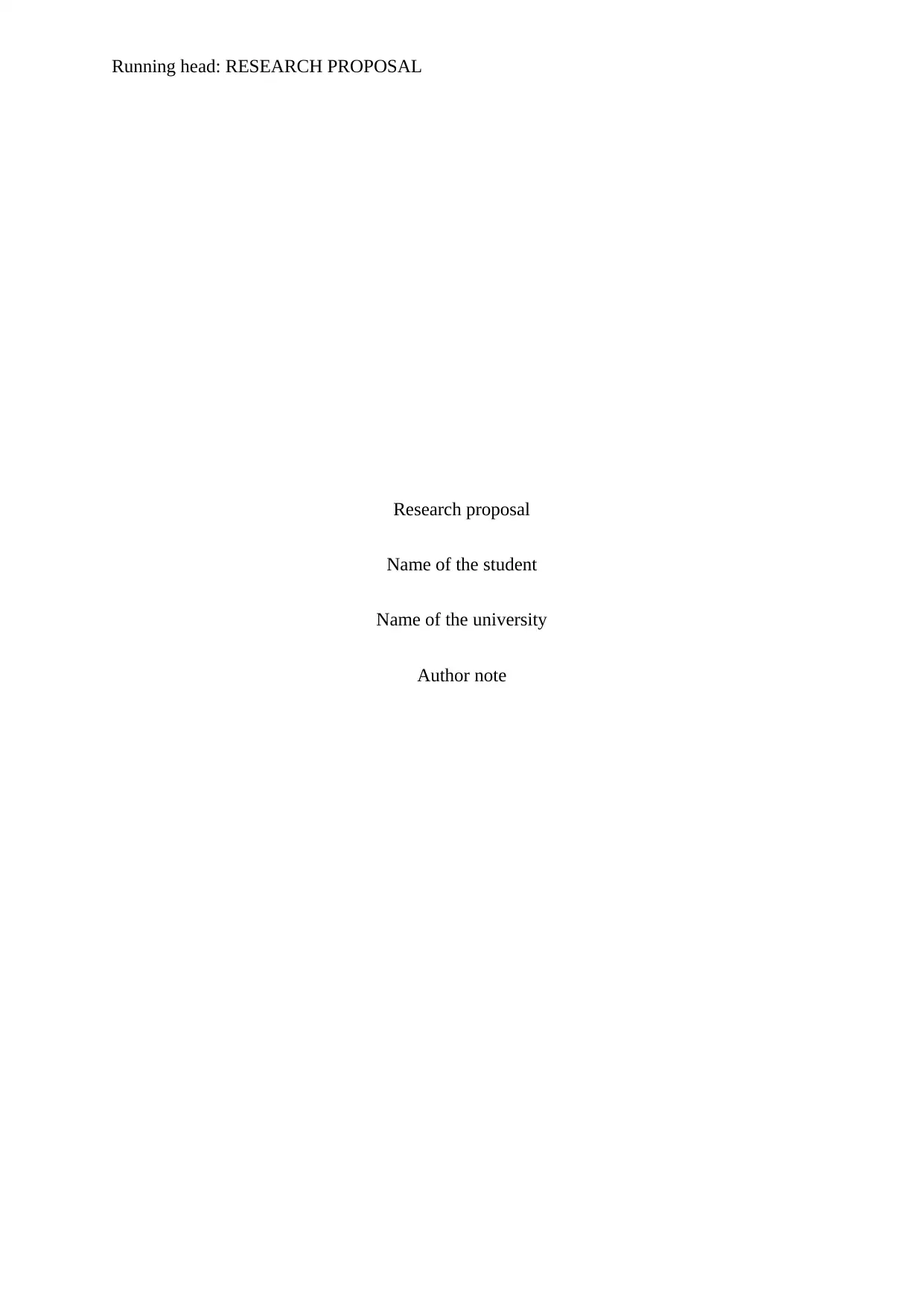
Running head: RESEARCH PROPOSAL
Research proposal
Name of the student
Name of the university
Author note
Research proposal
Name of the student
Name of the university
Author note
Paraphrase This Document
Need a fresh take? Get an instant paraphrase of this document with our AI Paraphraser
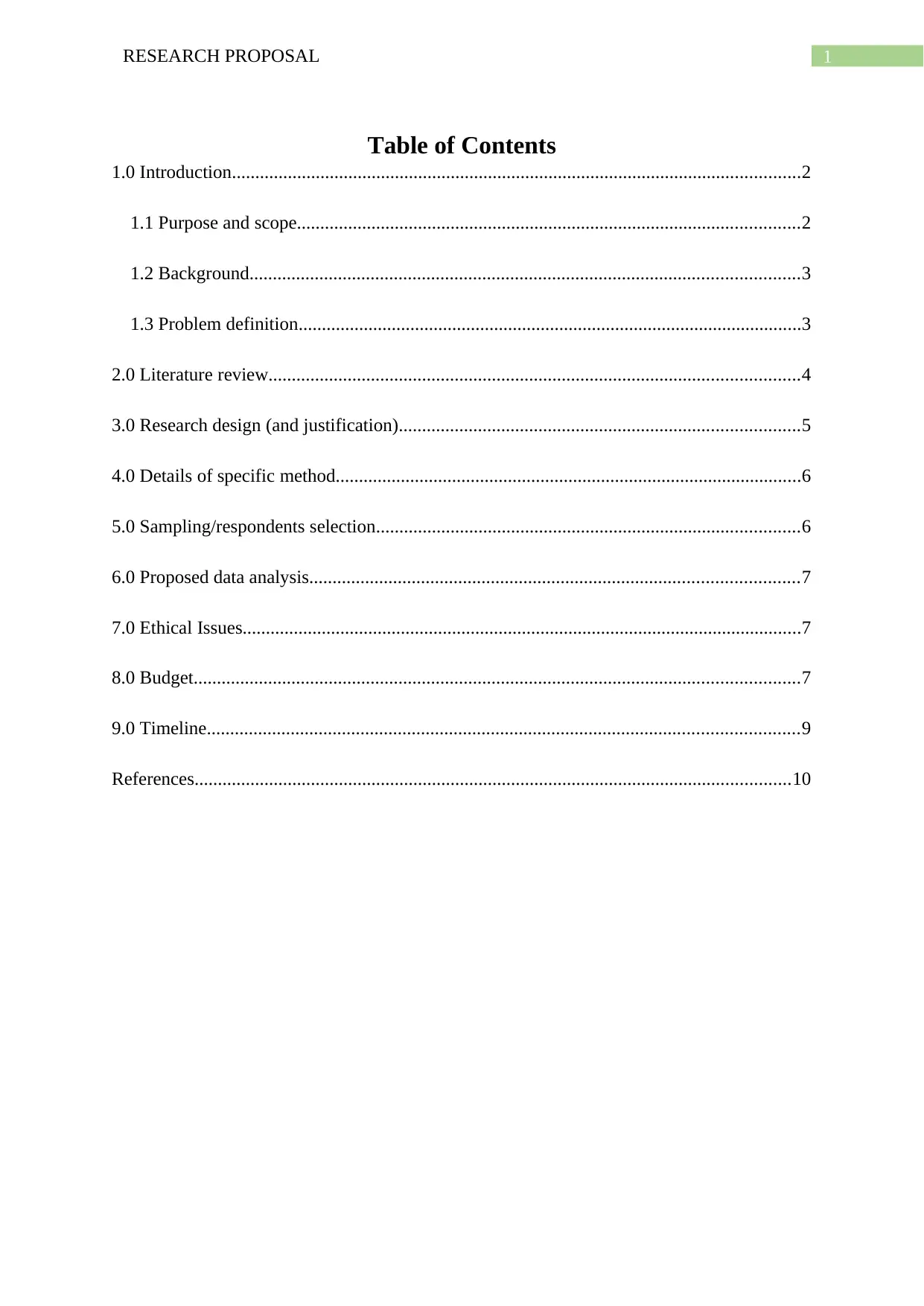
1RESEARCH PROPOSAL
Table of Contents
1.0 Introduction..........................................................................................................................2
1.1 Purpose and scope............................................................................................................2
1.2 Background......................................................................................................................3
1.3 Problem definition............................................................................................................3
2.0 Literature review..................................................................................................................4
3.0 Research design (and justification)......................................................................................5
4.0 Details of specific method....................................................................................................6
5.0 Sampling/respondents selection...........................................................................................6
6.0 Proposed data analysis.........................................................................................................7
7.0 Ethical Issues........................................................................................................................7
8.0 Budget..................................................................................................................................7
9.0 Timeline...............................................................................................................................9
References................................................................................................................................10
Table of Contents
1.0 Introduction..........................................................................................................................2
1.1 Purpose and scope............................................................................................................2
1.2 Background......................................................................................................................3
1.3 Problem definition............................................................................................................3
2.0 Literature review..................................................................................................................4
3.0 Research design (and justification)......................................................................................5
4.0 Details of specific method....................................................................................................6
5.0 Sampling/respondents selection...........................................................................................6
6.0 Proposed data analysis.........................................................................................................7
7.0 Ethical Issues........................................................................................................................7
8.0 Budget..................................................................................................................................7
9.0 Timeline...............................................................................................................................9
References................................................................................................................................10

2RESEARCH PROPOSAL
Topic: Impact of communication gap on organisational behaviour and profitability - “A case
study of Deloitte”
1.0 Introduction
1.1 Purpose and scope
The research proposes to examine the communication between the workforce and the
management within Deloitte and its influence on the organisational behaviour. The purpose
and scope of the study has been defined around this goal and they are as follows:
Introducing the definition of organizational communication and discussing the
importance of the same.
Discussing about the layers and structures of communication that are present within
organizations.
Discussing the models of communication that guide the organizational conducts and
are practiced within the structure.
Identifying the communication structure that re practiced within the chosen
organization.
Identifying the drawbacks within the communication structure, within the
organization and identifying the factors that affect the communication structure of the
chosen organization.
Impact of the communication gap upon the organization behaviour.
Research Questions
What are the communicational related problems that are perceived within the organization?
How these communication gap impacting upon the organizational behaviour?
Topic: Impact of communication gap on organisational behaviour and profitability - “A case
study of Deloitte”
1.0 Introduction
1.1 Purpose and scope
The research proposes to examine the communication between the workforce and the
management within Deloitte and its influence on the organisational behaviour. The purpose
and scope of the study has been defined around this goal and they are as follows:
Introducing the definition of organizational communication and discussing the
importance of the same.
Discussing about the layers and structures of communication that are present within
organizations.
Discussing the models of communication that guide the organizational conducts and
are practiced within the structure.
Identifying the communication structure that re practiced within the chosen
organization.
Identifying the drawbacks within the communication structure, within the
organization and identifying the factors that affect the communication structure of the
chosen organization.
Impact of the communication gap upon the organization behaviour.
Research Questions
What are the communicational related problems that are perceived within the organization?
How these communication gap impacting upon the organizational behaviour?
⊘ This is a preview!⊘
Do you want full access?
Subscribe today to unlock all pages.

Trusted by 1+ million students worldwide
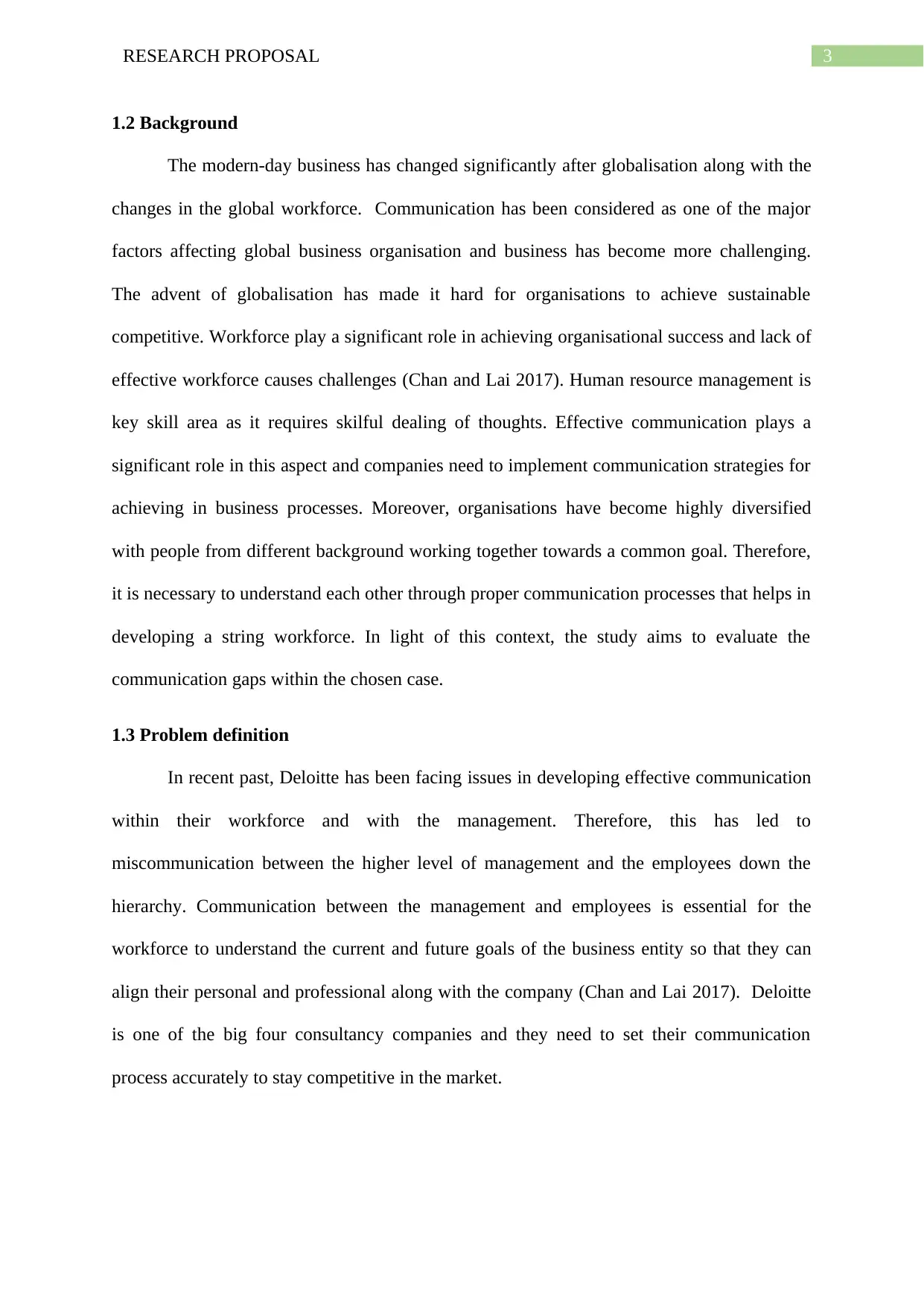
3RESEARCH PROPOSAL
1.2 Background
The modern-day business has changed significantly after globalisation along with the
changes in the global workforce. Communication has been considered as one of the major
factors affecting global business organisation and business has become more challenging.
The advent of globalisation has made it hard for organisations to achieve sustainable
competitive. Workforce play a significant role in achieving organisational success and lack of
effective workforce causes challenges (Chan and Lai 2017). Human resource management is
key skill area as it requires skilful dealing of thoughts. Effective communication plays a
significant role in this aspect and companies need to implement communication strategies for
achieving in business processes. Moreover, organisations have become highly diversified
with people from different background working together towards a common goal. Therefore,
it is necessary to understand each other through proper communication processes that helps in
developing a string workforce. In light of this context, the study aims to evaluate the
communication gaps within the chosen case.
1.3 Problem definition
In recent past, Deloitte has been facing issues in developing effective communication
within their workforce and with the management. Therefore, this has led to
miscommunication between the higher level of management and the employees down the
hierarchy. Communication between the management and employees is essential for the
workforce to understand the current and future goals of the business entity so that they can
align their personal and professional along with the company (Chan and Lai 2017). Deloitte
is one of the big four consultancy companies and they need to set their communication
process accurately to stay competitive in the market.
1.2 Background
The modern-day business has changed significantly after globalisation along with the
changes in the global workforce. Communication has been considered as one of the major
factors affecting global business organisation and business has become more challenging.
The advent of globalisation has made it hard for organisations to achieve sustainable
competitive. Workforce play a significant role in achieving organisational success and lack of
effective workforce causes challenges (Chan and Lai 2017). Human resource management is
key skill area as it requires skilful dealing of thoughts. Effective communication plays a
significant role in this aspect and companies need to implement communication strategies for
achieving in business processes. Moreover, organisations have become highly diversified
with people from different background working together towards a common goal. Therefore,
it is necessary to understand each other through proper communication processes that helps in
developing a string workforce. In light of this context, the study aims to evaluate the
communication gaps within the chosen case.
1.3 Problem definition
In recent past, Deloitte has been facing issues in developing effective communication
within their workforce and with the management. Therefore, this has led to
miscommunication between the higher level of management and the employees down the
hierarchy. Communication between the management and employees is essential for the
workforce to understand the current and future goals of the business entity so that they can
align their personal and professional along with the company (Chan and Lai 2017). Deloitte
is one of the big four consultancy companies and they need to set their communication
process accurately to stay competitive in the market.
Paraphrase This Document
Need a fresh take? Get an instant paraphrase of this document with our AI Paraphraser
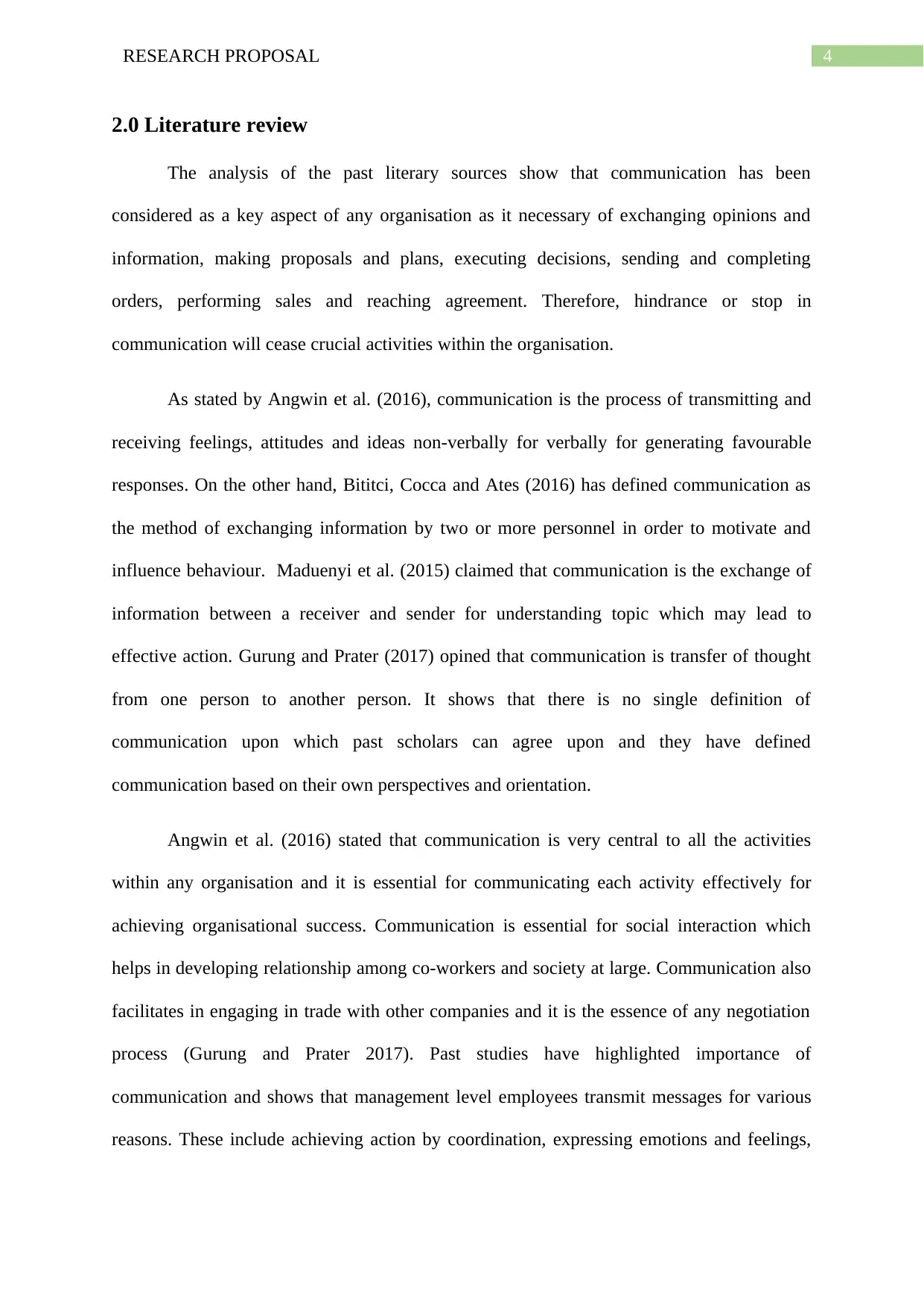
4RESEARCH PROPOSAL
2.0 Literature review
The analysis of the past literary sources show that communication has been
considered as a key aspect of any organisation as it necessary of exchanging opinions and
information, making proposals and plans, executing decisions, sending and completing
orders, performing sales and reaching agreement. Therefore, hindrance or stop in
communication will cease crucial activities within the organisation.
As stated by Angwin et al. (2016), communication is the process of transmitting and
receiving feelings, attitudes and ideas non-verbally for verbally for generating favourable
responses. On the other hand, Bititci, Cocca and Ates (2016) has defined communication as
the method of exchanging information by two or more personnel in order to motivate and
influence behaviour. Maduenyi et al. (2015) claimed that communication is the exchange of
information between a receiver and sender for understanding topic which may lead to
effective action. Gurung and Prater (2017) opined that communication is transfer of thought
from one person to another person. It shows that there is no single definition of
communication upon which past scholars can agree upon and they have defined
communication based on their own perspectives and orientation.
Angwin et al. (2016) stated that communication is very central to all the activities
within any organisation and it is essential for communicating each activity effectively for
achieving organisational success. Communication is essential for social interaction which
helps in developing relationship among co-workers and society at large. Communication also
facilitates in engaging in trade with other companies and it is the essence of any negotiation
process (Gurung and Prater 2017). Past studies have highlighted importance of
communication and shows that management level employees transmit messages for various
reasons. These include achieving action by coordination, expressing emotions and feelings,
2.0 Literature review
The analysis of the past literary sources show that communication has been
considered as a key aspect of any organisation as it necessary of exchanging opinions and
information, making proposals and plans, executing decisions, sending and completing
orders, performing sales and reaching agreement. Therefore, hindrance or stop in
communication will cease crucial activities within the organisation.
As stated by Angwin et al. (2016), communication is the process of transmitting and
receiving feelings, attitudes and ideas non-verbally for verbally for generating favourable
responses. On the other hand, Bititci, Cocca and Ates (2016) has defined communication as
the method of exchanging information by two or more personnel in order to motivate and
influence behaviour. Maduenyi et al. (2015) claimed that communication is the exchange of
information between a receiver and sender for understanding topic which may lead to
effective action. Gurung and Prater (2017) opined that communication is transfer of thought
from one person to another person. It shows that there is no single definition of
communication upon which past scholars can agree upon and they have defined
communication based on their own perspectives and orientation.
Angwin et al. (2016) stated that communication is very central to all the activities
within any organisation and it is essential for communicating each activity effectively for
achieving organisational success. Communication is essential for social interaction which
helps in developing relationship among co-workers and society at large. Communication also
facilitates in engaging in trade with other companies and it is the essence of any negotiation
process (Gurung and Prater 2017). Past studies have highlighted importance of
communication and shows that management level employees transmit messages for various
reasons. These include achieving action by coordination, expressing emotions and feelings,

5RESEARCH PROPOSAL
sharing information, achieving organisational goals, decision making, achieving control,
developing effective public image and encouraging staffs.
Maduenyi et al. (2015) states that organisation performance can be defined as the
comparison between the original output with the expected output which implies the
objectives and goals of any business entity. According to Bititci, Cocca and Ates (2016),
organisational performance addresses three particular areas of firm outcomes. This included
product market performance, shareholder return and financial performance. Chan and Lai
(2017) highlighted that in the recent past many organisations have tried to manage their
performance using the balance scorecard method which measures the performance in
multiple dimensions. It includes factors such as customer services, social responsibility,
financial performance and employee stewardship.
The analysis of the past empirical studies has highlighted the relationship between
these variables effectively. Angwin et al. (2016) performed a study to examine the impact of
organisational communication on the performance of employees and organisation. The results
showed that communication played a significant role in motivation and enhancing the
performance of employees. It is due to the ability of communication to deal with tighter
staffing, longer hours, emphasis on performance, flexibility and increase workloads. Ruck,
Welch and Menara (2017) performed a study to highlight that modern organisations consists
of cross and multi-functional teams which does not show much tolerance for undisputed
authority. This situation requires proper communication and persuasion where two
communication is required to com to any conclusion. Raina and Roebuck (2016) examined
the relationship between communication approach and firm performance in Nigerian bottling
company which showed that there is synergy between performance and communication
approach.
sharing information, achieving organisational goals, decision making, achieving control,
developing effective public image and encouraging staffs.
Maduenyi et al. (2015) states that organisation performance can be defined as the
comparison between the original output with the expected output which implies the
objectives and goals of any business entity. According to Bititci, Cocca and Ates (2016),
organisational performance addresses three particular areas of firm outcomes. This included
product market performance, shareholder return and financial performance. Chan and Lai
(2017) highlighted that in the recent past many organisations have tried to manage their
performance using the balance scorecard method which measures the performance in
multiple dimensions. It includes factors such as customer services, social responsibility,
financial performance and employee stewardship.
The analysis of the past empirical studies has highlighted the relationship between
these variables effectively. Angwin et al. (2016) performed a study to examine the impact of
organisational communication on the performance of employees and organisation. The results
showed that communication played a significant role in motivation and enhancing the
performance of employees. It is due to the ability of communication to deal with tighter
staffing, longer hours, emphasis on performance, flexibility and increase workloads. Ruck,
Welch and Menara (2017) performed a study to highlight that modern organisations consists
of cross and multi-functional teams which does not show much tolerance for undisputed
authority. This situation requires proper communication and persuasion where two
communication is required to com to any conclusion. Raina and Roebuck (2016) examined
the relationship between communication approach and firm performance in Nigerian bottling
company which showed that there is synergy between performance and communication
approach.
⊘ This is a preview!⊘
Do you want full access?
Subscribe today to unlock all pages.

Trusted by 1+ million students worldwide
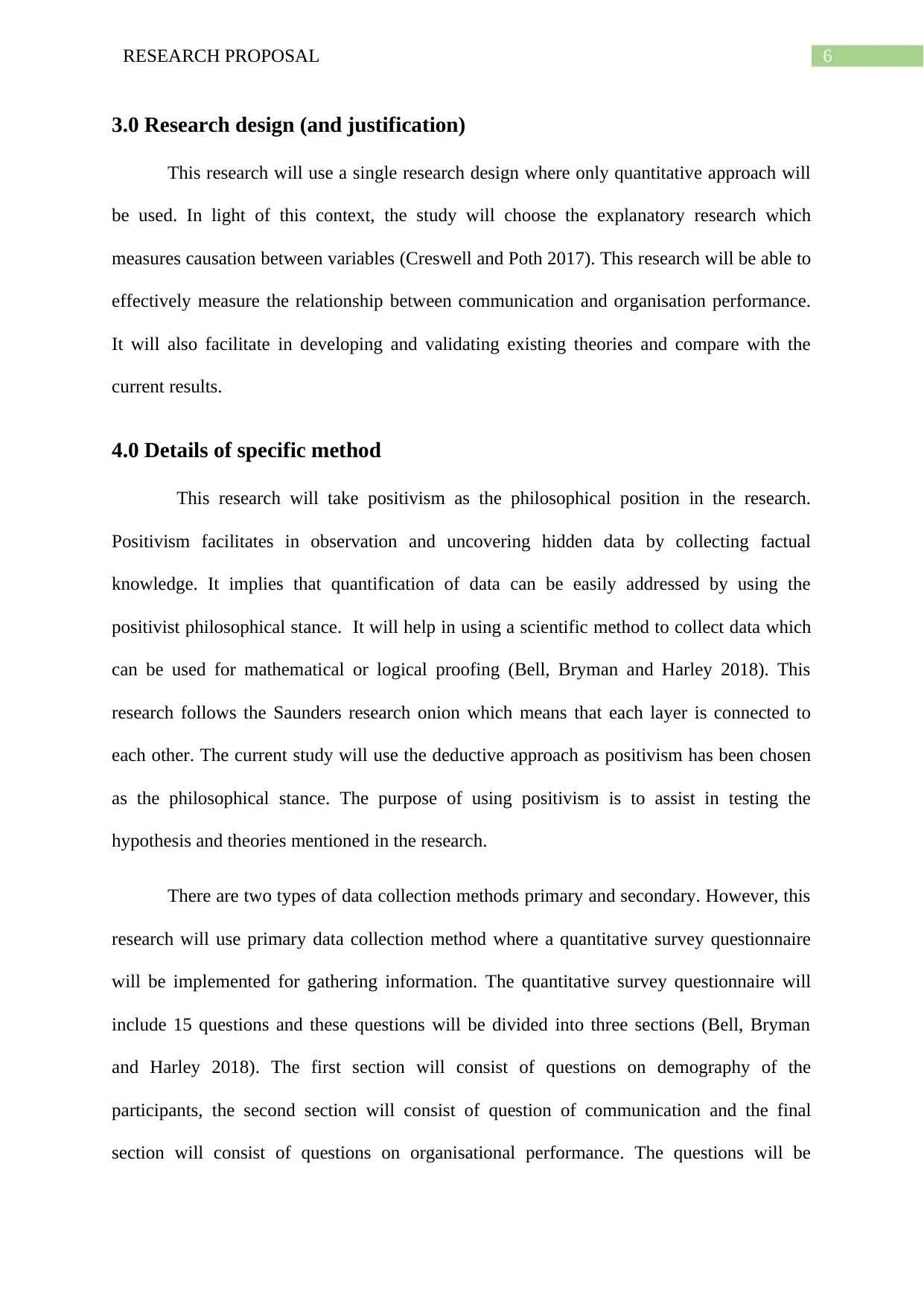
6RESEARCH PROPOSAL
3.0 Research design (and justification)
This research will use a single research design where only quantitative approach will
be used. In light of this context, the study will choose the explanatory research which
measures causation between variables (Creswell and Poth 2017). This research will be able to
effectively measure the relationship between communication and organisation performance.
It will also facilitate in developing and validating existing theories and compare with the
current results.
4.0 Details of specific method
This research will take positivism as the philosophical position in the research.
Positivism facilitates in observation and uncovering hidden data by collecting factual
knowledge. It implies that quantification of data can be easily addressed by using the
positivist philosophical stance. It will help in using a scientific method to collect data which
can be used for mathematical or logical proofing (Bell, Bryman and Harley 2018). This
research follows the Saunders research onion which means that each layer is connected to
each other. The current study will use the deductive approach as positivism has been chosen
as the philosophical stance. The purpose of using positivism is to assist in testing the
hypothesis and theories mentioned in the research.
There are two types of data collection methods primary and secondary. However, this
research will use primary data collection method where a quantitative survey questionnaire
will be implemented for gathering information. The quantitative survey questionnaire will
include 15 questions and these questions will be divided into three sections (Bell, Bryman
and Harley 2018). The first section will consist of questions on demography of the
participants, the second section will consist of question of communication and the final
section will consist of questions on organisational performance. The questions will be
3.0 Research design (and justification)
This research will use a single research design where only quantitative approach will
be used. In light of this context, the study will choose the explanatory research which
measures causation between variables (Creswell and Poth 2017). This research will be able to
effectively measure the relationship between communication and organisation performance.
It will also facilitate in developing and validating existing theories and compare with the
current results.
4.0 Details of specific method
This research will take positivism as the philosophical position in the research.
Positivism facilitates in observation and uncovering hidden data by collecting factual
knowledge. It implies that quantification of data can be easily addressed by using the
positivist philosophical stance. It will help in using a scientific method to collect data which
can be used for mathematical or logical proofing (Bell, Bryman and Harley 2018). This
research follows the Saunders research onion which means that each layer is connected to
each other. The current study will use the deductive approach as positivism has been chosen
as the philosophical stance. The purpose of using positivism is to assist in testing the
hypothesis and theories mentioned in the research.
There are two types of data collection methods primary and secondary. However, this
research will use primary data collection method where a quantitative survey questionnaire
will be implemented for gathering information. The quantitative survey questionnaire will
include 15 questions and these questions will be divided into three sections (Bell, Bryman
and Harley 2018). The first section will consist of questions on demography of the
participants, the second section will consist of question of communication and the final
section will consist of questions on organisational performance. The questions will be
Paraphrase This Document
Need a fresh take? Get an instant paraphrase of this document with our AI Paraphraser
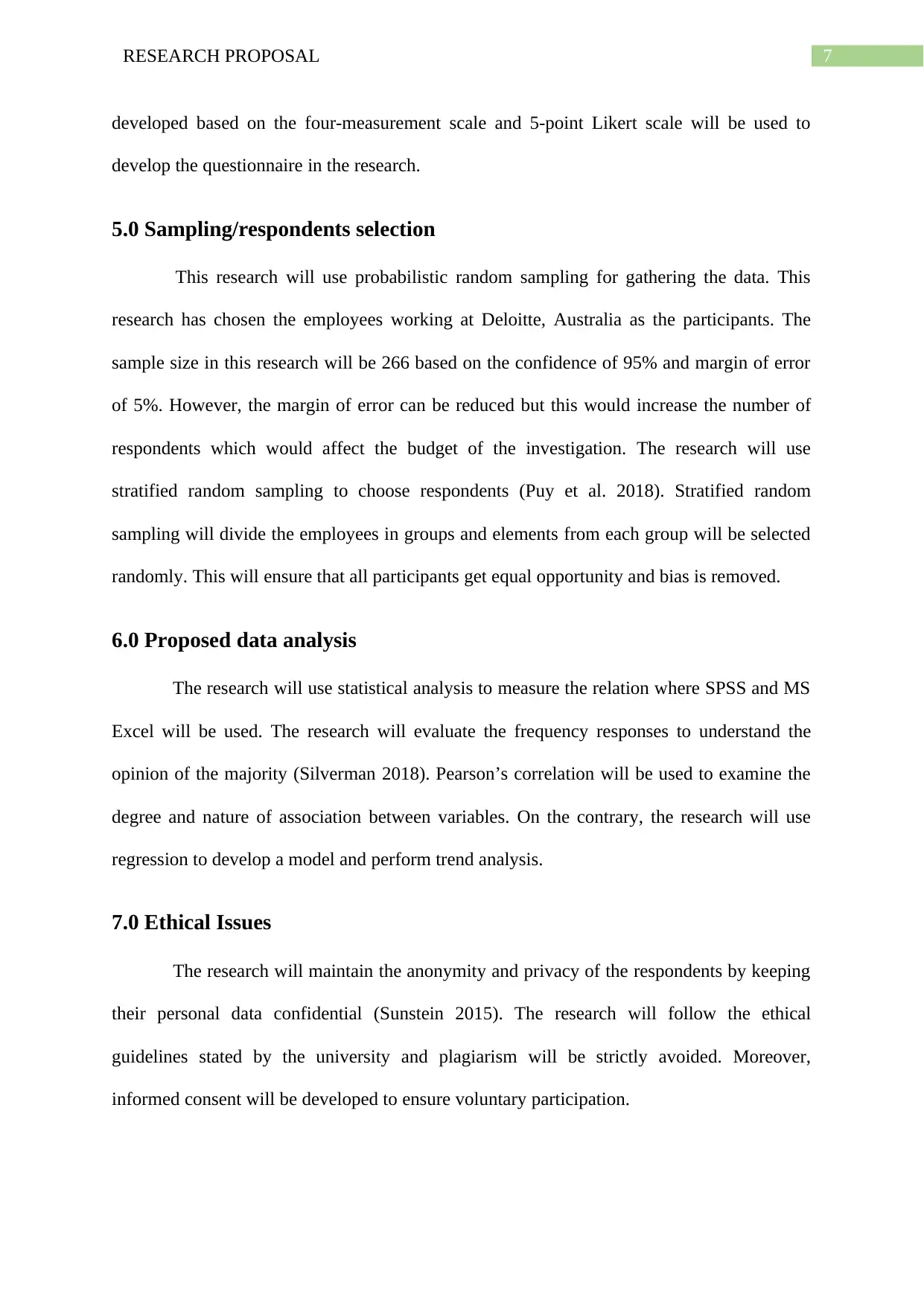
7RESEARCH PROPOSAL
developed based on the four-measurement scale and 5-point Likert scale will be used to
develop the questionnaire in the research.
5.0 Sampling/respondents selection
This research will use probabilistic random sampling for gathering the data. This
research has chosen the employees working at Deloitte, Australia as the participants. The
sample size in this research will be 266 based on the confidence of 95% and margin of error
of 5%. However, the margin of error can be reduced but this would increase the number of
respondents which would affect the budget of the investigation. The research will use
stratified random sampling to choose respondents (Puy et al. 2018). Stratified random
sampling will divide the employees in groups and elements from each group will be selected
randomly. This will ensure that all participants get equal opportunity and bias is removed.
6.0 Proposed data analysis
The research will use statistical analysis to measure the relation where SPSS and MS
Excel will be used. The research will evaluate the frequency responses to understand the
opinion of the majority (Silverman 2018). Pearson’s correlation will be used to examine the
degree and nature of association between variables. On the contrary, the research will use
regression to develop a model and perform trend analysis.
7.0 Ethical Issues
The research will maintain the anonymity and privacy of the respondents by keeping
their personal data confidential (Sunstein 2015). The research will follow the ethical
guidelines stated by the university and plagiarism will be strictly avoided. Moreover,
informed consent will be developed to ensure voluntary participation.
developed based on the four-measurement scale and 5-point Likert scale will be used to
develop the questionnaire in the research.
5.0 Sampling/respondents selection
This research will use probabilistic random sampling for gathering the data. This
research has chosen the employees working at Deloitte, Australia as the participants. The
sample size in this research will be 266 based on the confidence of 95% and margin of error
of 5%. However, the margin of error can be reduced but this would increase the number of
respondents which would affect the budget of the investigation. The research will use
stratified random sampling to choose respondents (Puy et al. 2018). Stratified random
sampling will divide the employees in groups and elements from each group will be selected
randomly. This will ensure that all participants get equal opportunity and bias is removed.
6.0 Proposed data analysis
The research will use statistical analysis to measure the relation where SPSS and MS
Excel will be used. The research will evaluate the frequency responses to understand the
opinion of the majority (Silverman 2018). Pearson’s correlation will be used to examine the
degree and nature of association between variables. On the contrary, the research will use
regression to develop a model and perform trend analysis.
7.0 Ethical Issues
The research will maintain the anonymity and privacy of the respondents by keeping
their personal data confidential (Sunstein 2015). The research will follow the ethical
guidelines stated by the university and plagiarism will be strictly avoided. Moreover,
informed consent will be developed to ensure voluntary participation.
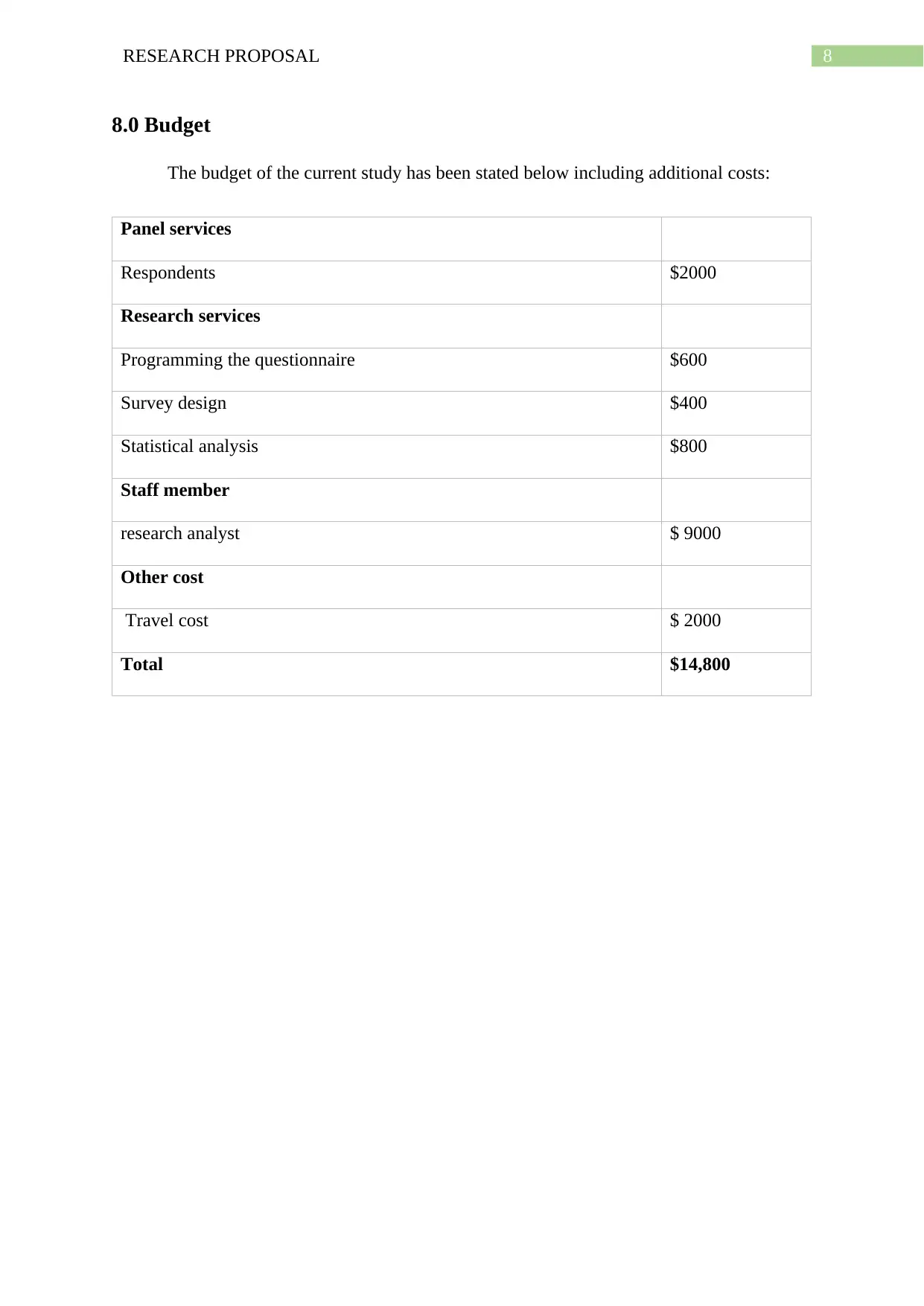
8RESEARCH PROPOSAL
8.0 Budget
The budget of the current study has been stated below including additional costs:
Panel services
Respondents $2000
Research services
Programming the questionnaire $600
Survey design $400
Statistical analysis $800
Staff member
research analyst $ 9000
Other cost
Travel cost $ 2000
Total $14,800
8.0 Budget
The budget of the current study has been stated below including additional costs:
Panel services
Respondents $2000
Research services
Programming the questionnaire $600
Survey design $400
Statistical analysis $800
Staff member
research analyst $ 9000
Other cost
Travel cost $ 2000
Total $14,800
⊘ This is a preview!⊘
Do you want full access?
Subscribe today to unlock all pages.

Trusted by 1+ million students worldwide
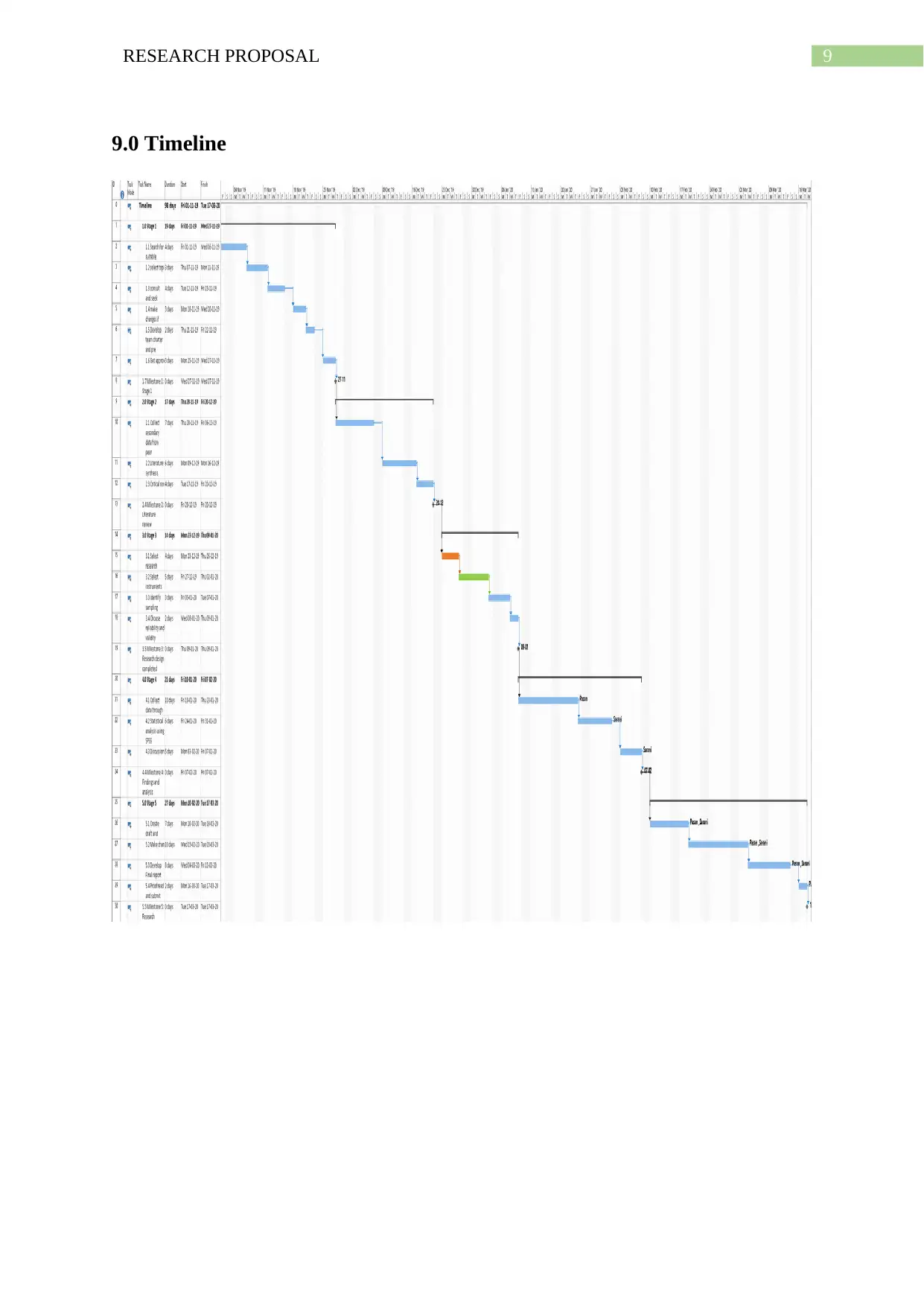
9RESEARCH PROPOSAL
9.0 Timeline
9.0 Timeline
Paraphrase This Document
Need a fresh take? Get an instant paraphrase of this document with our AI Paraphraser
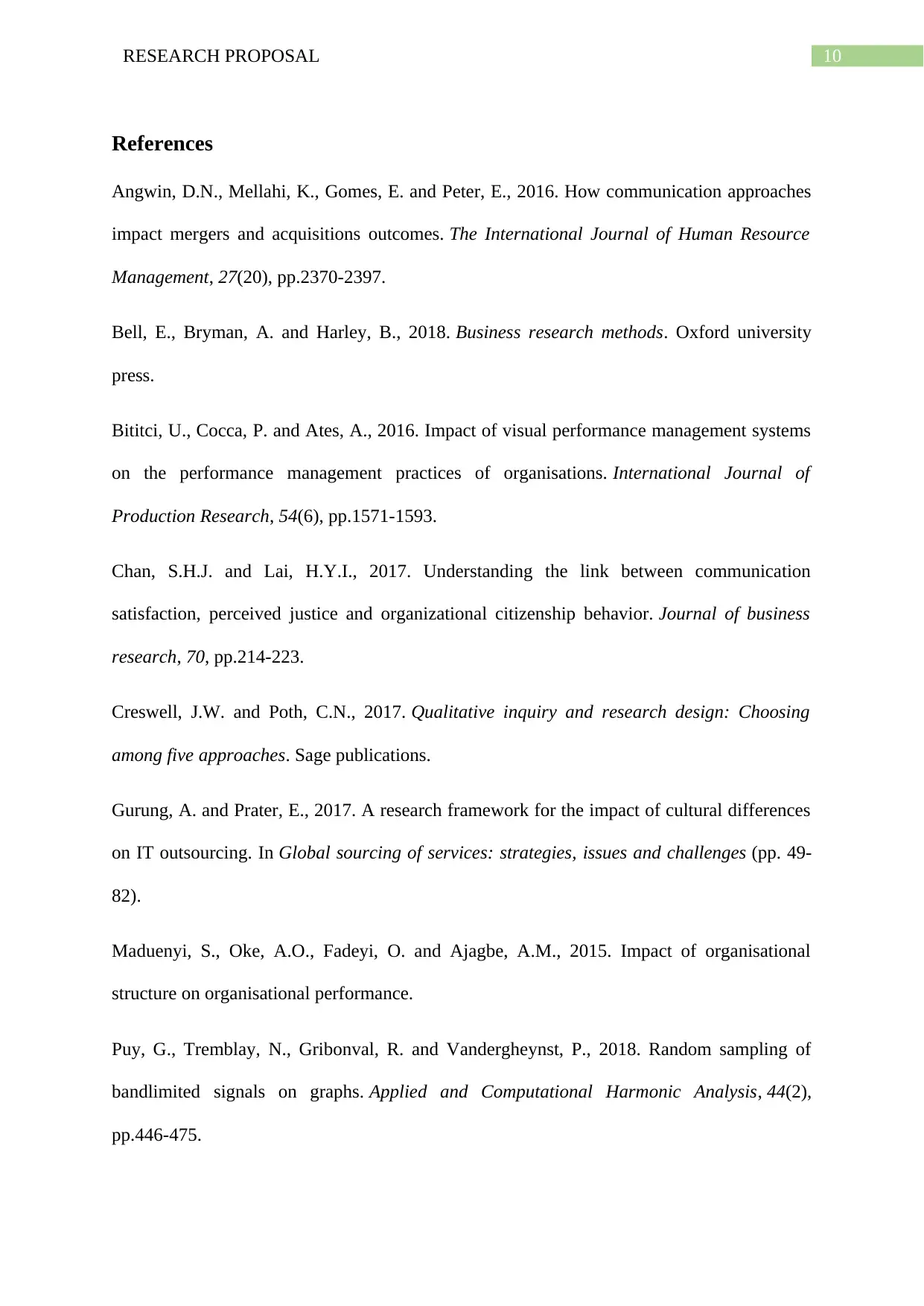
10RESEARCH PROPOSAL
References
Angwin, D.N., Mellahi, K., Gomes, E. and Peter, E., 2016. How communication approaches
impact mergers and acquisitions outcomes. The International Journal of Human Resource
Management, 27(20), pp.2370-2397.
Bell, E., Bryman, A. and Harley, B., 2018. Business research methods. Oxford university
press.
Bititci, U., Cocca, P. and Ates, A., 2016. Impact of visual performance management systems
on the performance management practices of organisations. International Journal of
Production Research, 54(6), pp.1571-1593.
Chan, S.H.J. and Lai, H.Y.I., 2017. Understanding the link between communication
satisfaction, perceived justice and organizational citizenship behavior. Journal of business
research, 70, pp.214-223.
Creswell, J.W. and Poth, C.N., 2017. Qualitative inquiry and research design: Choosing
among five approaches. Sage publications.
Gurung, A. and Prater, E., 2017. A research framework for the impact of cultural differences
on IT outsourcing. In Global sourcing of services: strategies, issues and challenges (pp. 49-
82).
Maduenyi, S., Oke, A.O., Fadeyi, O. and Ajagbe, A.M., 2015. Impact of organisational
structure on organisational performance.
Puy, G., Tremblay, N., Gribonval, R. and Vandergheynst, P., 2018. Random sampling of
bandlimited signals on graphs. Applied and Computational Harmonic Analysis, 44(2),
pp.446-475.
References
Angwin, D.N., Mellahi, K., Gomes, E. and Peter, E., 2016. How communication approaches
impact mergers and acquisitions outcomes. The International Journal of Human Resource
Management, 27(20), pp.2370-2397.
Bell, E., Bryman, A. and Harley, B., 2018. Business research methods. Oxford university
press.
Bititci, U., Cocca, P. and Ates, A., 2016. Impact of visual performance management systems
on the performance management practices of organisations. International Journal of
Production Research, 54(6), pp.1571-1593.
Chan, S.H.J. and Lai, H.Y.I., 2017. Understanding the link between communication
satisfaction, perceived justice and organizational citizenship behavior. Journal of business
research, 70, pp.214-223.
Creswell, J.W. and Poth, C.N., 2017. Qualitative inquiry and research design: Choosing
among five approaches. Sage publications.
Gurung, A. and Prater, E., 2017. A research framework for the impact of cultural differences
on IT outsourcing. In Global sourcing of services: strategies, issues and challenges (pp. 49-
82).
Maduenyi, S., Oke, A.O., Fadeyi, O. and Ajagbe, A.M., 2015. Impact of organisational
structure on organisational performance.
Puy, G., Tremblay, N., Gribonval, R. and Vandergheynst, P., 2018. Random sampling of
bandlimited signals on graphs. Applied and Computational Harmonic Analysis, 44(2),
pp.446-475.
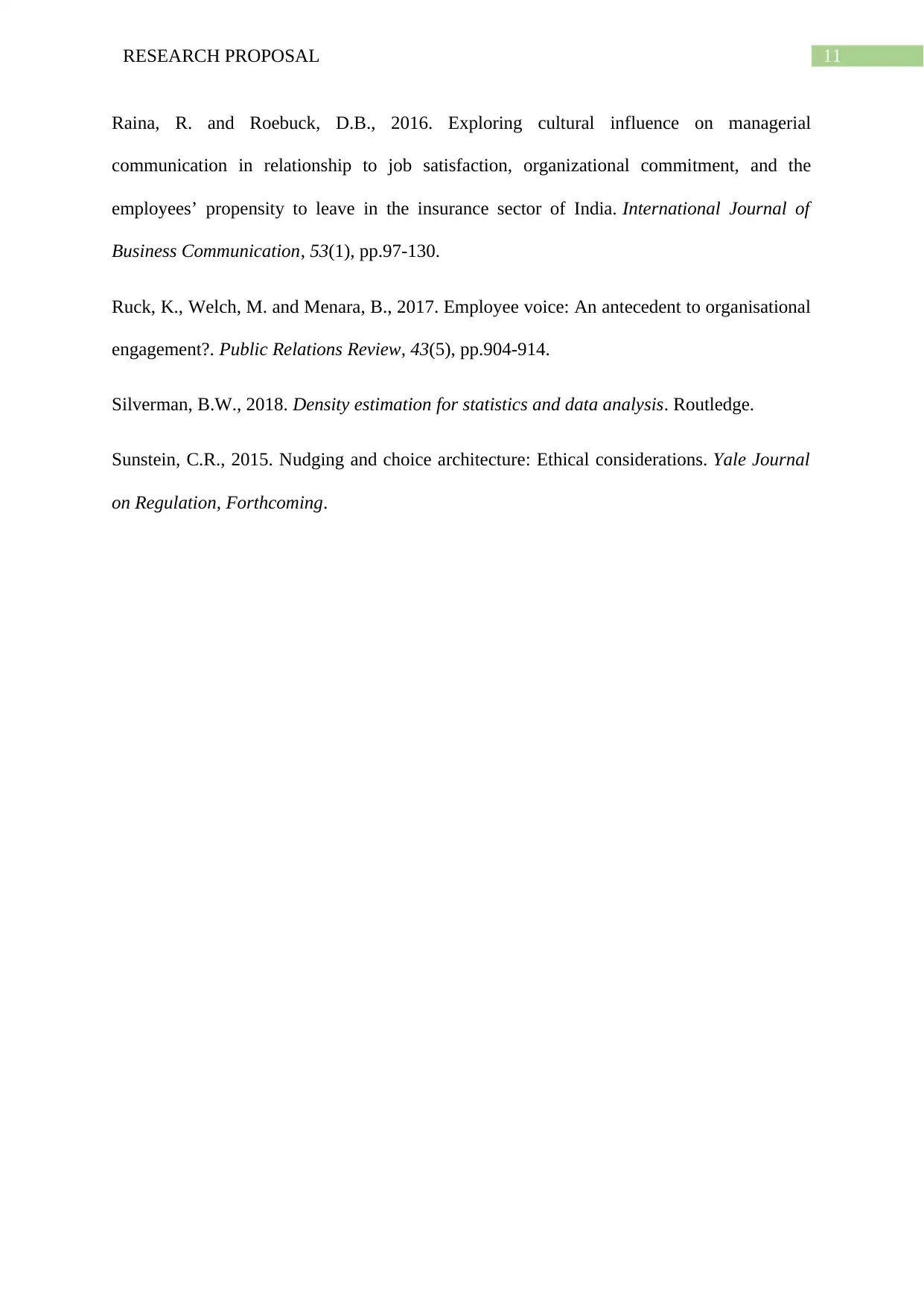
11RESEARCH PROPOSAL
Raina, R. and Roebuck, D.B., 2016. Exploring cultural influence on managerial
communication in relationship to job satisfaction, organizational commitment, and the
employees’ propensity to leave in the insurance sector of India. International Journal of
Business Communication, 53(1), pp.97-130.
Ruck, K., Welch, M. and Menara, B., 2017. Employee voice: An antecedent to organisational
engagement?. Public Relations Review, 43(5), pp.904-914.
Silverman, B.W., 2018. Density estimation for statistics and data analysis. Routledge.
Sunstein, C.R., 2015. Nudging and choice architecture: Ethical considerations. Yale Journal
on Regulation, Forthcoming.
Raina, R. and Roebuck, D.B., 2016. Exploring cultural influence on managerial
communication in relationship to job satisfaction, organizational commitment, and the
employees’ propensity to leave in the insurance sector of India. International Journal of
Business Communication, 53(1), pp.97-130.
Ruck, K., Welch, M. and Menara, B., 2017. Employee voice: An antecedent to organisational
engagement?. Public Relations Review, 43(5), pp.904-914.
Silverman, B.W., 2018. Density estimation for statistics and data analysis. Routledge.
Sunstein, C.R., 2015. Nudging and choice architecture: Ethical considerations. Yale Journal
on Regulation, Forthcoming.
⊘ This is a preview!⊘
Do you want full access?
Subscribe today to unlock all pages.

Trusted by 1+ million students worldwide
1 out of 12
Related Documents
Your All-in-One AI-Powered Toolkit for Academic Success.
+13062052269
info@desklib.com
Available 24*7 on WhatsApp / Email
![[object Object]](/_next/static/media/star-bottom.7253800d.svg)
Unlock your academic potential
© 2024 | Zucol Services PVT LTD | All rights reserved.





